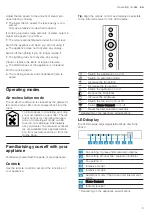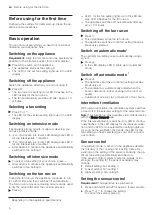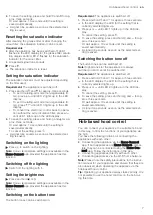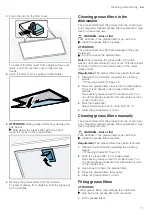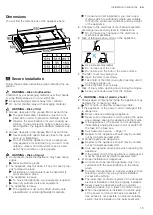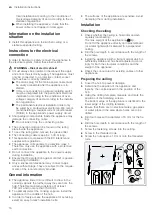
en
Preventing material damage
4
WARNING ‒ Risk of electric shock!
¡
If the appliance or the power cord is dam-
aged, this is dangerous.
▶
Never operate a damaged appliance.
▶
Never pull on the power cord to unplug
the appliance. Always unplug the appli-
ance at the mains.
▶
If the appliance or the power cord is
damaged, immediately unplug the
power cord or switch off the fuse in the
fuse box.
▶
▶
Repairs to the appliance should only
be carried out by trained specialist
staff.
¡
Improper repairs are dangerous.
▶
Repairs to the appliance should only
be carried out by trained specialist
staff.
▶
Only use genuine spare parts when re-
pairing the appliance.
▶
If the power cord of this appliance is
damaged, it must be replaced by
trained specialist staff.
¡
An ingress of moisture can cause an elec-
tric shock.
▶
Before cleaning, pull out the mains
plug or switch off the fuse in the fuse
box.
▶
Do not use steam- or high-pressure
cleaners to clean the appliance.
WARNING ‒ Risk of explosion!
Highly caustic alkaline or highly acidic
cleaning agents in conjunction with alu-
minium parts in the interior of the appli-
ance may cause explosions.
▶
Never use highly caustic alkaline or
highly acidic cleaning agents. In partic-
ular, do not use commercial or indus-
trial cleaning agents in conjunction with
aluminium parts, e.g. grease filter on
extractor hoods.
Preventing material damage
Follow these instructions to prevent material damage to
your appliance, accessories or other objects in your kit-
chen.
General
Follow these instructions when using the appliance.
ATTENTION!
¡
Condensate may cause corrosion damage.
▶
To prevent condensation from building up, switch
on the appliance during cooking.
¡
If moisture gets into the controls, this may result in
damage.
▶
Never clean controls with a wet cloth.
¡
Incorrect cleaning damages the surfaces.
▶
Follow the cleaning instructions.
▶
Do not use harsh or abrasive detergents.
▶
Clean stainless steel surfaces in the direction of
the finish only.
▶
Never clean controls with stainless steel clean-
ers.
¡
Condensation that flows back in may damage the
appliance.
▶
The air extraction duct must be installed with a
gradient of at least 1° from the appliance.
¡
If you put incorrect stress on the design elements,
they may break off.
▶
Do not pull design elements.
▶
Do not place objects on the design elements or
hang objects from them.
¡
Leaking batteries may damage the remote control.
▶
Remove the batteries if you are not using the re-
mote control.
▶
Safely dispose of the empty or defective batteries
in an environmentally friendly manner.
¡
There is a risk of surface damage if you do not peel
off the protective film.
▶
Remove the protective film from all parts of the
appliance before using for the first time.
Environmental protection and
saving energy
Help protect the environment by using your appliance
in a way that conserves resources and by disposing of
reusable materials properly.
Disposing of packaging
The packaging materials are environmentally compat-
ible and can be recycled.
▶
Sort the individual components by type and dispose
of them separately.
Information about current disposal methods are
available from your specialist dealer or local author-
ity.
Saving energy
If you follow these instructions, your appliance will use
less power.
Ensure that there is sufficient ventilation when cook-
ing.
The appliance works more efficiently and with fewer
operating noises.





